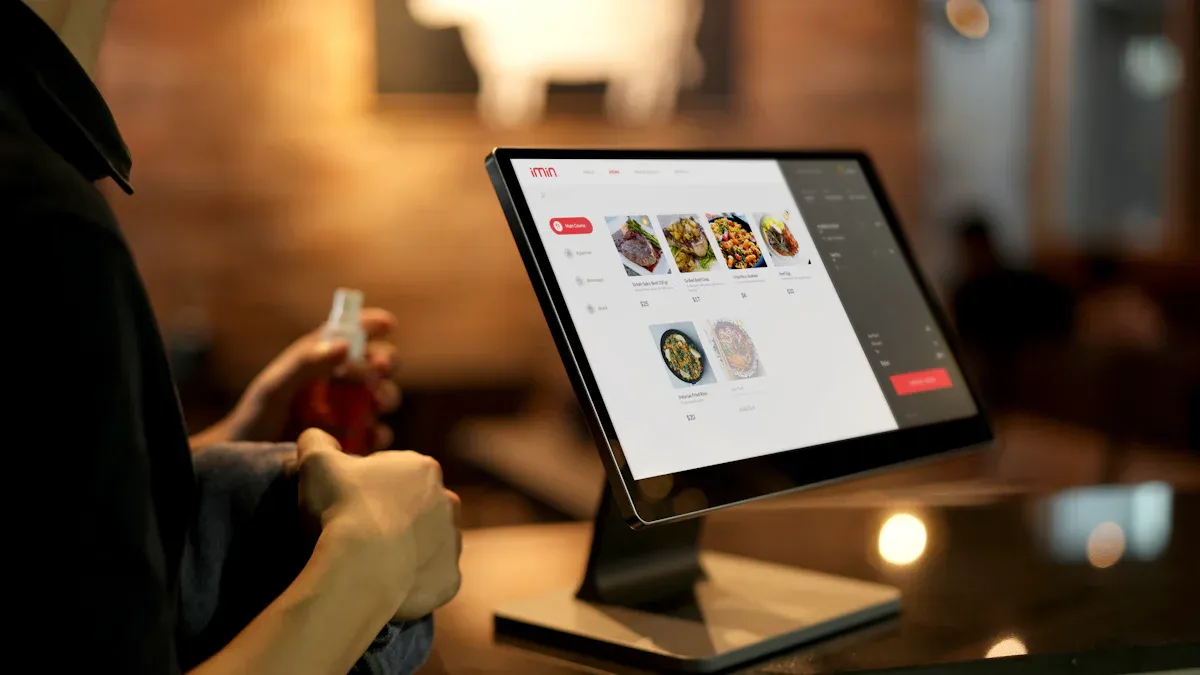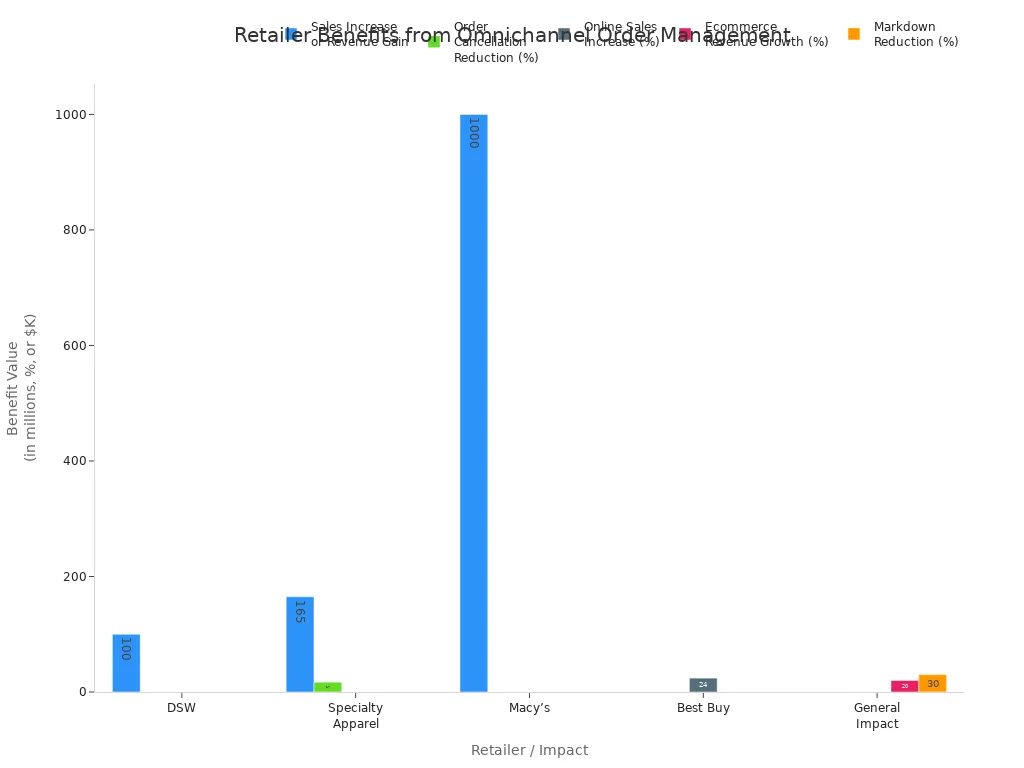
Omnichannel order management transforms the retail landscape by giving you a single platform to unify your order processes and data. You boost customer experience across desktop, mobile, and in-store channels. This approach delivers faster, more reliable service and drives higher conversion rates. The table below shows how omnichannel strategies outperform single-channel models:
Channel Type | Conversion Rate Range |
|---|---|
Mobile (Online) | |
Omnichannel Impact | Up to 20% increase |
You gain a real-time view of customers, streamline mobile and in-store experiences, and position your business for long-term retail success.
Omnichannel Order Management Defined

What Is It?
Omnichannel order management gives you a single platform to connect every sales channel—online, in-store, and mobile. You use this system to track inventory in real time, manage orders, and deliver a seamless experience for your customers. With omni-channel order management, you can unify customer, order, and inventory data across all touchpoints. This approach supports ecommerce, point of sale, and mobile commerce, making it easy to offer flexible fulfillment options like buy online, pick up in store (BOPIS), ship from store, or curbside pickup.
Tip: A strong omni-channel order management system lets your customers shop, return, and exchange items anywhere, giving them more control and convenience.
Key features you gain from omni-channel order management systems include:
Unified inventory management across ecommerce, mobile, and physical stores
Smart order routing to optimize fulfillment and reduce shipping costs
Real-time visibility into orders and inventory
Personalized experiences based on customer data
Robust reporting for sales, inventory, and customer behavior
Here’s a quick look at the core components:
Core Component | Description |
|---|---|
Enterprise Inventory Visibility | See accurate stock levels across all channels, including mobile and ecommerce platforms. |
Order Aggregation | Manage all orders from one hub, whether they come from mobile commerce, online, or in-store. |
Order Fulfillment | Automate picking, packing, and shipping to speed up delivery and lower costs. |
Customer Service | Track the full order lifecycle and make changes as needed, improving the customer experience. |
Why It Matters
You need omni-channel order management to stay competitive in today’s retail world. Customers expect to shop and interact with your brand on their terms—whether through mobile, ecommerce, or in-store. Omni-channel order management systems help you meet these expectations by giving you real-time insights and control.
With omni-channel order management, you:
Improve supply chain management by tracking inventory and orders everywhere
Prevent stockouts and overstocking, so you always have the right products available
Deliver faster, more accurate shipping and returns, boosting customer satisfaction
Centralize customer data for hyper-personalized marketing and loyalty programs
Reduce fulfillment errors and optimize inventory control
You also gain the ability to adapt quickly to changes in demand, whether customers shop through mobile commerce, ecommerce, or physical stores. This flexibility helps you increase sales, build loyalty, and create a seamless omni-channel experience that sets your brand apart.
Benefits of Omnichannel Order Management

Customer Experience
You deliver a customer-centric experience when you use omni-channel order management. Customers expect to move smoothly between online, mobile, and in-store shopping. Omni-channel systems let you meet these expectations by connecting every touchpoint. You give customers fast, secure checkouts and real-time order tracking. You also make returns and exchanges simple, which builds trust and satisfaction.
A 5% increase in customer retention can boost profits by 25% or more. Fast checkouts, synchronized promotions, and easy order tracking all help you keep customers coming back.
You can see how leading brands improve customer experience with omni-channel order management:
Company | Omnichannel Implementation | Customer Experience Improvement |
|---|---|---|
Sweetgreen | Mobile app, website, and in-store kiosks for ordering, customization, and rewards. | Streamlined ordering and consistent engagement across channels. |
Home Depot | Integrated website, app, and stores with AR, product scanning, live chat, and inventory checks. | Consistent, innovative, and expert-supported shopping experience. |
Zendesk | Unified support channels (email, chat, phone, social media) with AI chatbots and context retention. | Smooth, personalized, and coherent customer support across channels. |
Bonobos | Website, app, and Guideshops for appointment-based try-before-you-buy shopping. | Unique, personalized shopping experience blending online and offline. |
You empower customers to shop, return, and interact with your brand on their terms. This seamless omni-channel approach leads to higher satisfaction and loyalty.
Sales Growth
Omni-channel order management drives sales growth by connecting all your sales channels and optimizing fulfillment. You can turn every store into a mini-warehouse, using store inventory to fulfill online orders. This strategy reduces shipping costs and speeds up delivery, which encourages more purchases.
Customers who shop across multiple channels spend three to four times more than those who use only one channel.
Laura Canada, a fashion retailer, saw a 25% revenue increase and 400% online sales growth after using omni-channel order management to turn stores into fulfillment centers. Digital touchpoints, like in-store digital signage, can boost sales by up to 33%. When you offer buy-online-pick-up-in-store, you increase average order value and drive more foot traffic to your stores.
You can see the measurable benefits reported by top retailers after adopting omni-channel order management:
Retailer | Measurable Benefit(s) | Details / Figures |
|---|---|---|
DSW | Increased omnichannel sales | Nearly $100 million increase after implementing ship-from-store program |
Best Buy | Reduced delivery times and increased online sales | Cut average delivery time by 2 days; 24% online sales increase during 2014 holiday season |
Specialty Apparel | Reduced order cancellations and increased sales | 17% reduction in cancelled orders; $165,000 additional sales in first 3 months |
Finish Line | High volume of online orders fulfilled from stores | Ships over 50% of online orders from 657 stores, with each store processing a dozen+ orders daily |
Toys"R" Us | Significant portion of ecommerce sales fulfilled via stores | 31% of global ecommerce sales fulfilled by ship-from-store or in-store pickup |
Macy’s | Annual sales growth attributed to ship-from-store program | $1 billion sales growth per year over 3 years; avoids markdowns and warehouse expansion |
Kohl’s | Cost savings and order attachment rates from BOPIS | Buy online pickup in store accounts for 6-7% of orders; saves $5 shipping cost per order; 15-20% attachment rates |
General Impact | Incremental ecommerce revenue growth, markdown reduction, and faster delivery times | Potential 20%+ ecommerce revenue increase; markdowns reduced by 30%+; faster, less expensive shipping |

You can boost conversion rates and average order value by offering flexible fulfillment options and showing accurate delivery estimates. Omni-channel order management helps you capture more sales and grow your retail business.
Inventory Visibility
You gain real-time inventory visibility with omni-channel order management. This means you always know what products you have and where they are. You avoid stockouts and overstock situations, which saves money and keeps customers happy.
Retailer / Source | Improvement / Statistic | Description / Impact |
|---|---|---|
Fabric OMS users | Improved customer engagement and sales efficiency due to better inventory visibility | |
Fabric OMS users | 30% reduction in total cost of ownership (TCO) | Operational efficiencies linked to improved inventory and order management |
Best Buy (CEO Corie Barry) | 250% increase in domestic online sales | Growth attributed to enhanced curbside and omni-channel capabilities |
Debenhams (via Fabric OMS) | Expanded to 3 million SKUs across 11 brands | Seamless management of large product catalogs, improving online shopping and operations |
You use real-time tracking to update stock levels instantly across all channels. This prevents selling the same item twice and reduces customer complaints. You also get early warnings to reorder before stock runs out. Technologies like barcoding and RFID make your inventory management more accurate and responsive.
Real-time inventory systems provide up-to-the-minute data, reducing errors and stockouts.
You monitor stock across all locations, ensuring product availability.
Early warnings help you avoid running out of popular items.
You identify slow-moving products and reduce overstock, saving money.
With omni-channel inventory management, you improve fulfillment accuracy and deliver a better customer experience.
Brand Loyalty
Omni-channel order management strengthens customer loyalty by delivering a consistent experience across every channel. You track customer interactions and preferences, which lets you personalize offers and rewards. When you recognize and reward customers for shopping both online and in-store, you build deeper relationships.
Omnichannel loyalty programs connect in-store, online, and mobile app experiences, making rewards seamless and personalized.
Customers in these programs spend more and return more often. For example, Walmart+ members spend $79 per online visit compared to $62 for non-members.
Companies with omni-channel engagement strategies retain 89% of their customers, while those without retain only 33%.
You can use gamification, like prize wheels or badges, to make loyalty programs more engaging. Consistent omni-channel experiences improve your brand reputation and encourage customers to recommend your business. Research shows that high-quality channel integration increases customer engagement and repurchase intention, which leads to stronger customer loyalty.
Note: When you deliver a seamless, customer-centric experience, you turn shoppers into loyal brand advocates who return again and again.
Omnichannel Operations: Challenges and Solutions
Integration
You face major integration challenges when connecting different systems in your retail business. Many retailers struggle with data silos, slow order processing, and manual work because their systems do not talk to each other. Legacy platforms often lack modern APIs, making it hard to connect new tools. Data scattered across channels leads to errors and inconsistent customer experiences.
Integration Challenge | Impact on Retailers | Suggested Solution |
|---|---|---|
Data silos, inefficient workflows, errors in order processing | Invest in integrated order management connecting sales, inventory, CRM, and analytics | |
Ineffective integration of channels and systems | Slow order processing, manual work, higher error risk | Create effective integration layers using middleware or APIs |
Scattered data across multiple sources | Time wasted retrieving latest data, inconsistent brand communication | Implement a single source of truth for content, product info, sales, and customer data |
Legacy systems lacking modern APIs | Difficult integration with new systems, limits omnichannel strategy | Gradually integrate legacy systems or adopt MACH architecture |
Lack of centralized analytics | Slow response to sales changes, manual data collection, difficulty measuring progress | Use business intelligence tools for unified dashboards and reports |
Tip: Cloud-based platforms and centralized data help you automate processes and reduce manual entry, making integration smoother.
Data Management
Managing data across multiple channels can overwhelm your team. Without a unified system, you risk errors, stockouts, and lost sales. Disconnected inventory systems make it hard to track products, while missing analytics slow down your decision-making.
Centralized inventory management gives you a real-time view of stock across all channels.
Real-time data synchronization ensures consistent product information and pricing.
Order management systems eliminate silos and streamline order processing.
Analytics dashboards help you understand customer behavior and improve operations.
Data security and compliance protect your customers and build trust.
Note: Master Data Management and cloud infrastructure improve data reliability and support your growth.
Technology Adoption
You may hesitate to adopt new technology due to cost, uncertainty, or technical challenges. Many businesses worry about return on investment, system compatibility, and service interruptions. Organizational culture and lack of clear strategy can also slow down technology adoption.
Uncertainty about where to start impacts over a third of retailers.
Technical issues like data migration and security require careful planning.
Staff training and change management are essential for smooth transitions.
Remember: Personal innovativeness and a clear strategy help you overcome barriers to technology adoption.
Solutions
You can streamline omnichannel operations by following proven solutions:
Centralize inventory visibility for real-time updates and dynamic order routing.
Deploy AI-driven order orchestration to optimize fulfillment speed and cost.
Unify online and offline channels for consistent pricing and promotions.
Automate manual processes to reduce errors and speed up fulfillment.
Use analytics and predictive tools to forecast demand and personalize offers.
Train your staff and support ongoing learning for new systems.
Monitor performance and adjust your strategy as you grow.
Solution Area | Key Benefits and Features |
|---|---|
Centralize and synchronize sales, inventory, and fulfillment operations; enable real-time data visibility. | |
Order Management Systems | Centralize orders from all channels; automate complex fulfillment; speed up order processing. |
Warehouse Management System | Consolidate inventory; automate fulfillment; support stock transfers. |
Product Information Management | Ensure consistent product and pricing data; automate updates; support promotions. |
Advanced Integration Capabilities | Integrate with existing systems using APIs; synchronize marketplaces, stores, and carriers. |
Staff Training and Change Management | Educate staff on channels, technology, and customer service for smooth transitions. |
By investing in integrated order management and unified systems, you gain real-time data, reduce errors, and deliver a seamless customer experience. This approach transforms omnichannel operations into a strategic advantage.
Future of Omni-Channel Order Management
AI and Automation
You will see AI and automation shape the next wave of omnichannel trends. AI-powered order management systems replace manual steps with intelligent automation. You can streamline everything from order capture to fulfillment and improve inventory visibility. AI automates repetitive tasks like order entry, shipping details, and inventory syncing. This frees your team to focus on customer experience. Automation speeds up order processing, reduces errors, and improves accuracy across all sales channels. AI also routes orders in real time, adapting to events like weather or stockouts. You get timely deliveries and fewer disruptions. The industrial automation market is expected to more than double by 2031, showing strong industry commitment.
AI automates order routing and fulfillment center selection.
Hyper-automation integrates RPA, AI, and analytics for end-to-end workflows.
AI supports seamless fulfillment options, including BOPIS and curbside pickup.
Predictive analytics optimize inventory and forecast demand.
Cloud-native systems enable real-time updates across mobile and in-store channels.
Personalization
Personalization will become even more advanced as AI technologies evolve. You can use AI to deliver predictive offers and adapt to real-time customer behavior. This creates context-aware marketing journeys across every channel, including mobile. The AI in e-commerce market is set to grow rapidly, reflecting strong adoption of AI-powered personalization. Hyper-personalization can increase average revenue per user by 166% and boost loyalty. You can analyze browsing, purchase history, and engagement to refine offers. Voice and visual search will make discovery easier on mobile commerce platforms. Retailers now connect customer profiles across channels, enabling tailored recommendations and real-time inventory checks. Unified commerce platforms help you break down data silos and deliver consistent experiences.
Unified customer data models support seamless personalization.
Personalized storefronts and targeted outreach drive higher engagement.
Flexible fulfillment options, like in-store pickup, support personalized experiences.
Predictive Analytics
You can use predictive analytics tools to transform your omnichannel order management. Leading retailers like Home Depot, ALDI, and PetSmart use advanced analytics to predict trends, optimize inventory, and manage supply chain risks. For example:
Retailer | Predictive Tool | Benefit |
|---|---|---|
Home Depot | Savanna® Prescriptive Analytics | Predicts transaction patterns and fraud |
ALDI | Heat mapping, video analytics | Optimizes store layouts and product selection |
PetSmart | FourKites platform | Predicts arrivals and manages delays |
Macy’s | Location-level pricing analytics | Boosts pricing strategies and digital sales |
You can also use tools like Tableau, Power BI, and Google Analytics 4 to visualize trends and forecast sales across mobile and in-store channels. Unified CRM systems help you integrate data from all touchpoints, making your order management more effective.
Emerging Tech
Emerging technologies will have a major impact on omnichannel order management. AI and machine learning improve demand forecasting and automate decisions. IoT devices give you real-time inventory tracking and better supply chain visibility. Blockchain technology provides transparency and authenticity verification. Enabling technologies like 5G, voice recognition, and APIs support real-time data flow and system integration. These advances help you deliver seamless digital and physical integration, transforming your supply chain and customer experience.
Tip: Stay ahead by adopting new technologies that improve efficiency, accuracy, and customer satisfaction across all channels, especially mobile.
Strategies for Omnichannel Success
Implementation Steps
You can build a strong omnichannel foundation by following a clear set of steps.
Transform your e-commerce platform into a marketplace. This expands your product assortment with third-party vendors and reduces inventory risks.
Use dropship rationalization powered by analytics. This helps you decide which products to dropship, optimizing inventory and fulfillment.
Validate new strategies before scaling. Run pilot projects for new fulfillment methods like curbside pickup. Conduct market research to understand what your customers want. Use order management simulations to forecast demand and test business rules.
Integrate all sales and communication channels. This creates a seamless experience and ensures customers interact with your brand, not isolated channels.
Choose a cloud-based omnichannel order management platform. This gives you real-time inventory visibility and a unified view of fulfillment.
Automate workflows to reduce errors and unify data.
Leverage advanced analytics to monitor orders, stock, and returns. This frees your team to focus on high-priority projects.
Tip: A unified commerce platform helps you optimize fulfillment options like BOPIS, curbside pickup, and dropshipping.
Best Practices
You can ensure success in integrated retail by following these best practices:
Implement an order management system that gives full visibility into the order lifecycle.
Consolidate inventory data from all sources for accuracy.
Use smart order orchestration to aggregate orders and optimize fulfillment.
Integrate payment, loyalty, and vendor systems for robust transaction processing.
Provide a customer service portal that handles order changes and supports a seamless experience.
Prioritize real-time visibility across inventory and delivery.
Use automated rate shopping to optimize shipping costs.
Analyze order and delivery data for actionable insights.
Measuring Results
You need to measure the impact of your omnichannel strategy.
Track customer interactions across all channels to spot engagement trends.
Analyze conversion rates and average order value for financial performance.
Collect customer feedback and retention rates to gauge satisfaction.
Use KPIs like fulfillment efficiency, return rate, and gross profit margin.
Metric | Description | Purpose |
|---|---|---|
Fulfillment Efficiency | Orders fulfilled on time | Evaluates order processing speed |
Return Rate | Returned items vs. total sold | Highlights product or experience issues |
Gross Profit Margin | Profitability by channel | Shows where cost optimization is needed |
Note: Regularly review these metrics to drive continuous improvement in your omnichannel platform.
You drive retail success when you embrace omnichannel order management. Unified systems and operational excellence create a strong foundation for growth:
You align people, processes, and technology to improve efficiency and deliver customer value.
You optimize supply chains, maintain product availability, and respond quickly to trends.
You build trust and loyalty by providing high-quality service across every channel.
Stay ahead by innovating and adapting to new trends. Now is the time to transform your business and lead the future of retail.
FAQ
What is the main benefit of omnichannel order management?
You gain a single view of orders and inventory across all channels. This helps you deliver faster service, reduce errors, and improve customer satisfaction.
Tip: Unified systems help you avoid stockouts and overstock.
How does omnichannel order management improve customer experience?
You let customers shop, return, or exchange items anywhere. You provide real-time order tracking and flexible delivery options. This builds trust and keeps customers coming back.
Can small retailers use omnichannel order management systems?
Yes, you can find scalable solutions designed for small businesses. Many cloud-based platforms offer affordable plans and easy setup.
Start with basic features.
Upgrade as your business grows.
What technology do you need for omnichannel order management?
You need a cloud-based order management system, real-time inventory tracking, and integration with sales channels. You may also use analytics tools for better decision-making.
Technology | Purpose |
|---|---|
OMS Platform | Centralizes orders |
Inventory System | Tracks stock |
Analytics Tools | Improves insights |
See Also
Top Brands Expand Rapidly Using WarpDriven Distribution Solutions
Key Features That Differentiate WarpDriven ERP For Smart Enterprises
The Role Of Distribution Management In Driving Worldwide Business